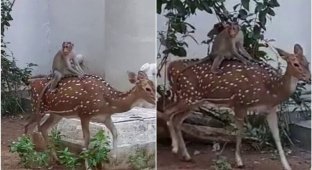Biologists explained why Japanese macaques saddle spotted deer (3 photos + 2 videos)
We are used to seeing various animals around humans - from pets that have become our friends to livestock that provide us with food. In nature, relationships between species develop, for example, in the form of mutualism, cooperation, when both participants benefit from the interaction. 
A striking example is the long "friendship" of the honey guide bird (Indicator) and the inhabitants of African tribes. As the name suggests, the birds tell people where there is honey in the forest. While the Africans are getting it (smoking out the bees), the bird waits patiently, because, as a rule, the locals thank it for its help - they leave wax, the honeyguide's main food.
Such symbiosis has also been observed in primates. Japanese macaques (Macaca fuscata) and spotted deer (Cervus nippon), living on the Japanese islands, share the same food resources. The monkeys, feeding on trees, break off branches and pluck leaves during their meal, which the deer eat from the ground. In addition, the primates search for parasites in the deer's fur, and the deer receive additional nutrients from the excrement of the macaques. 
It seems to be a fairly typical case of interspecies cooperation, but these animals also engage in social play. Japanese macaques have been repeatedly observed sitting on the backs of sika deer. Although this was not observed very often, the reasons why the primates saddled them remained unclear. Recently, biologists from Japan, France and Canada explained this behavior of the monkeys with a number of hypotheses and presented them in an article published in the journal Primates.
Experts watched videos taken in forests on the Japanese island of Yakushima and in the city of Minoh. They asked other researchers to share their observations and collected about ten videos, which included 45 episodes of interactions between Japanese macaques and sika deer - in 28 cases, the monkeys saddled them.
The biologists identified several actions of the primates. The macaques imitated sexual behavior (rubbed against their backs, stimulating their genitals), rested, lying on the backs of the deer, played (this was how they denoted non-aggressive touches, grabbing by the horns, biting), and also combed their fur (grooming). The primates also chased the deer, bared their teeth, expressing obvious aggression, scared them off with jumps and sharp gestures, but all this happened without climbing on the ungulates. 
A special program that calculated the duration of each action in seconds allowed the researchers to determine that most often the macaques rested on the backs of deer (96.7% of cases). The second most popular activity was imitation of sexual behavior (38.7%), and play and grooming occurred in 12.9% of cases. It is worth considering that during one interaction, the monkeys performed different operations, so the sum of the percentages exceeds 100%.
Biologists were surprised that not a single saddling was carried out solely for the purpose of transportation - the macaques did not ride anywhere on deer. It is also noteworthy that the sika deer did not let themselves be offended when the game crossed the line: ten attempts to throw the monkeys off their backs were recorded, seven of them were successful.
Explaining such a diverse behavior of Japanese macaques, the researchers formulated five hypotheses. Firstly, sexualized movements may be a consequence of the fact that there was no partner for some macaques in the group. And the semen that the males sometimes left on the deer's fur after their manipulations was eaten by the ungulates (both males and females) - biologists regarded it as a possible source of proteins.
Secondly, resting on the backs of deer may be an attempt to warm up. But at the same time, specialists did not record cases when primates lay in an embrace with them while the ungulates were on the ground. There is not enough data to confirm this hypothesis. Third, the macaques probably use the deer specifically for rest: in different poses, the females and males spent a lot of time on the backs of the deer.
Fourth, grooming and playing with the ungulates strengthened social ties between the two species. According to the researchers, combing and searching for parasites supported mutual tolerance, and the games probably developed social relationships in the monkeys. Fifth, the aggression that arose between the species was most likely due to competition for territory or resources (macaques and deer feed on the same vegetation). But the scientists were unable to determine the motives for this aggression.
In general, to expand our understanding of the interaction of Japanese macaques with sika deer, long-term observations are needed, since the relationship between the two species most likely evolved.

























